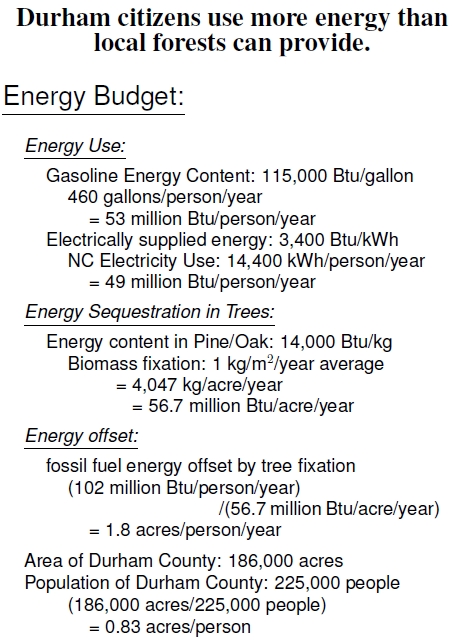3.17 Energy Footprint
Figure 3.17: A calculation of Durham County citizens’ energy footprint. On a per capita basis, energy use represents 1.8 acres of net primary production by plants, but the county only has 0.83 acre on a per citizen measure. These numbers for personal use underestimate total energy use, from Figure 3.1, of 100 quadrillion Btus for 300 million Americans, yielding 330 million Btu/person/year. This energy offset would require more than 5 acres.
Here’s an “energy footprint” calculation (Figure 3.17). For North Carolina, per capita energy consumption, both fuel and electricity (see Figure 3.2), sums to about 100 million Btu/year. Given Durham County’s 0.83 acre/person (3,400 m2/person), these numbers mean that North Carolinians “locally” add about 30,000 Btu/m2/year in heat through energy use, or about 80 Btu/m2/day. We aren’t directly heating up the Earth by using energy: In comparison, solar radiation adds about 16,400 Btu/m2/day at Earth’s surface.[86] There’s a lot of solar heat energy compared to our measly energy use.
How does our energy use relate to trees? Suppose we could achieve biomass fixation of 1 kg/m2/year (see Figure 1.6), representing 14,000 Btu/m2/year (about 0.3% of the incident light energy), close to the natural amount, and about half our localized energy use. In other words, if we could harvest all the biomass fixed yearly off of 1.8 acres, in a sustainable way assuring the same harvest year after year, that biomass would provide the energy each North Carolinian uses in one year.[87] But Durham County’s residents only have 0.83 acre per person, including urban areas. Our energy footprint exceeds our county boundaries.
If we could grow energy supercrops that fix 10% of incident light energy every day of the year, we’d produce 1,360 Btu/m2 of biomass each day.[88] If we could then convert 10% of that biomass to usable energy to power cars and dishwashers and light bulbs, we’d have 136 Btu/m2/day, about double what North Carolinians use today.
If the calculation isn’t too silly, let’s get a bit more realistic about biomass conversion. Hoped-for biomass fixation for short-rotation woody crops tops out at 84 Btu/m2/day before conversion to fuels.[89] With a 10% biomass-to-energy conversion efficiency, that would provide about 8 Btu/m2/day, roughly 10% of the energy we use personally. Of course, we couldn’t live and produce food crops on the land on which we’re growing energy crops, nor could we have slow-growing trees, wildlife, and healthy soils.
Earlier I mentioned the terrestrial Earth has about 5.8 acres per person across the globe, with a world average biomass fixation around 1 kg/m2/year. Harvesting all of this biomass, each human would have about 24,000 kg (and other organisms none), representing 336 million Btus each. As I calculated here, North Carolinians personally use about 102 million Btus, or about one-third our individual biomass harvest.[90] We already capture about 40% of the world’s net primary productivity for many purposes, a capture that already appears beyond sustainability, as evidenced by environmental degradation and high species extinction rates.[91] Seemingly, urbanites’ focus must be on using urban trees to reduce energy demands, not fulfill their energy desires.
———————————————–
[86]Kiehl and Trenberth (2002) provide a solar radiation budget I use to compare human energy use. These comparisons change pretty drastically for a place like New York City. There citizens have about 40 m2/person, and if they used the same energy on a daily basis, their energy use would amount to 6,800 Btu/m2/day. Still, that number is less than the solar input of 16,400 Btu/m2/day at Earth’s surface, but an astonishingly sizable fraction.
[87]I’ll point out a serious underestimate here. I used per capita personal use of fuel and electricity, not the U.S.-wide total energy consumption. The latter number means we need to harvest all the biomass off of 5.5 acres per Durham citizen.
[88]This is not possible.
[89]Using the annual sequestration rates for SRWC of 2.2 kg/m2 mentioned by Graham et al. (1992), use an energy conversion of 14,000 Btu/kg and 365 days per year: (2.2 kg/m2)(14,000 Btu/kg)/(365 days/year) = 84 Btu/m2/day.
[90]If everyone in the world used energy like Americans, measured from the U.S.-wide total energy consumption, humans’ energy use would equal the entire biosphere’s biomass fixation. Biomass is not a viable complete energy solution.
[91]One of the most recent estimates determined that humans capture, most likely, 40% of Earth’s net primary productivity — meaning that almost one-half of all the material that plants generate from photosynthesis, either directly or through higher trophic levels. Rojstaczer et al. (2001) updates the Vitousek et al. (1986) calculations that estimated 20 to 40% of the world’s primary productivity is captured and used by humans. That’s a big, unsustainable ecological footprint for our species. Indeed, accounting for human use of a variety of land and ocean areas, it has been estimated that humans overshot sustainability sometime around 1979, and, in 1999, used about 20% more than the Earth could produce sustainably. Wackernagel et al. (2002) discuss how much humans have overshot sustainability.
